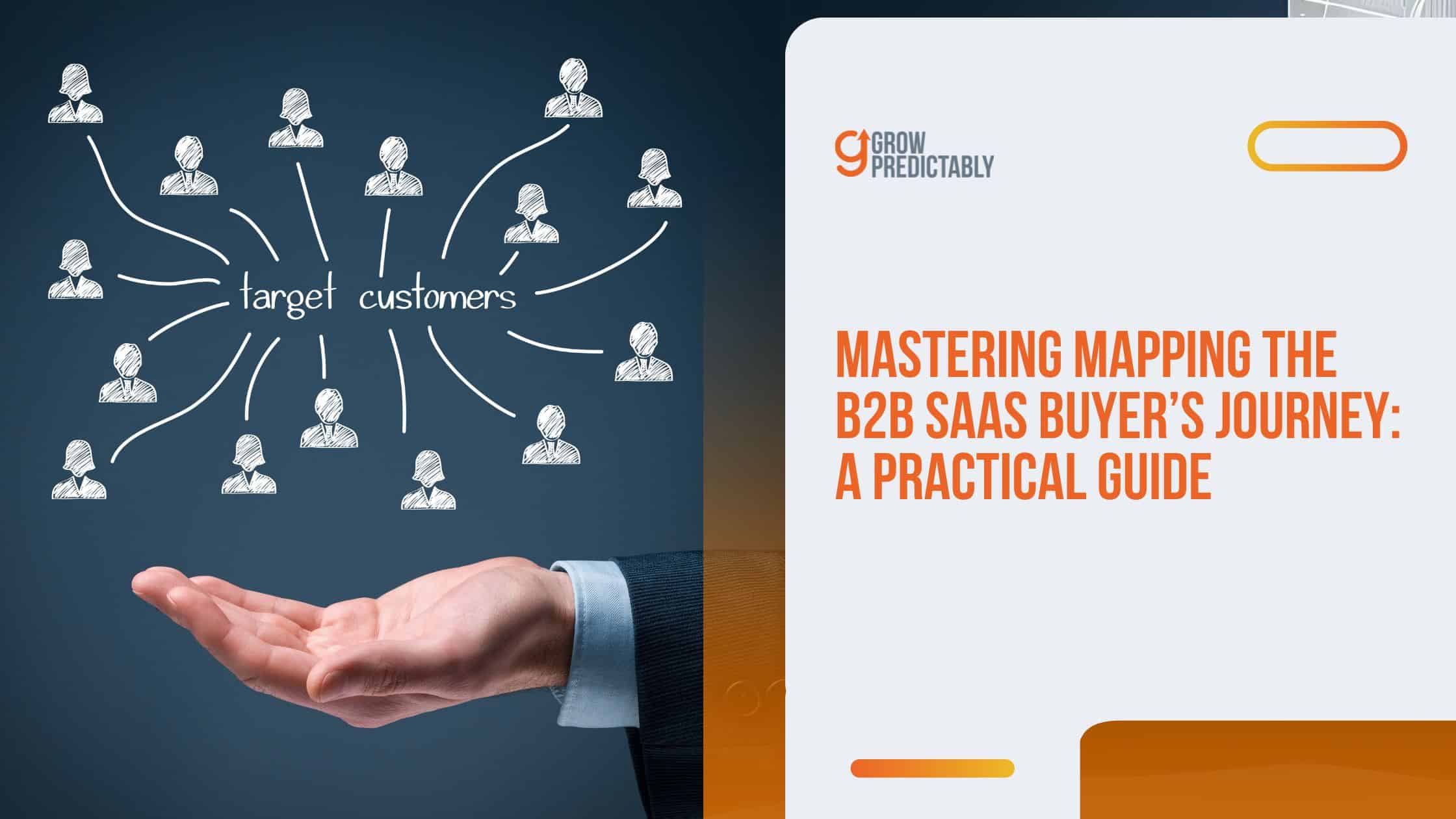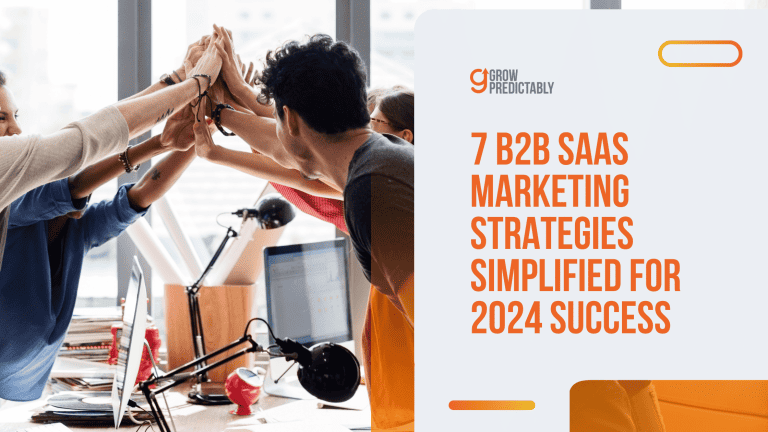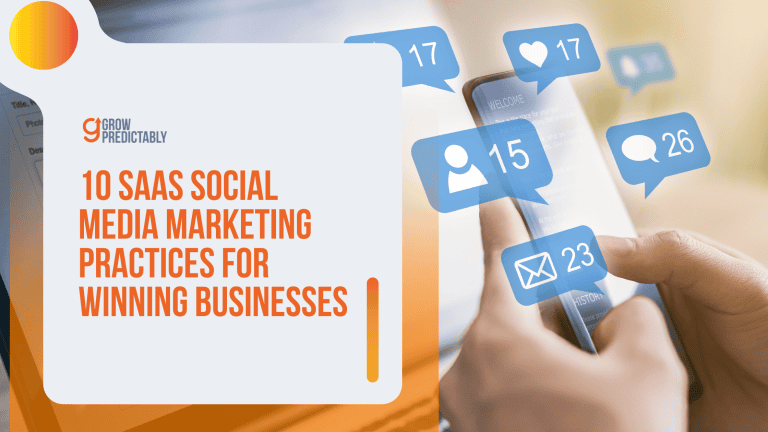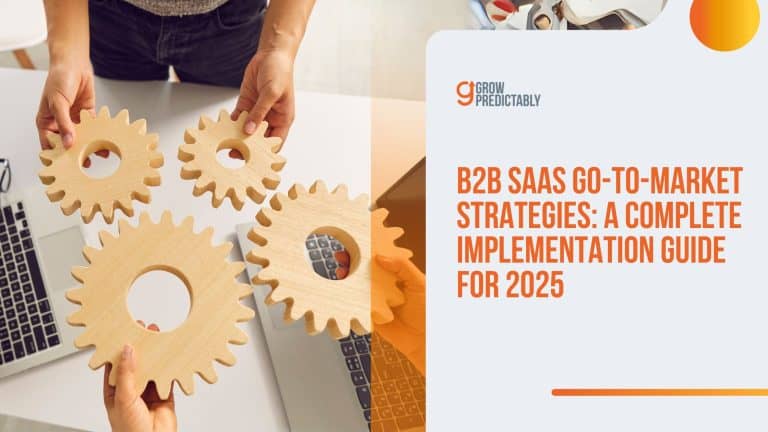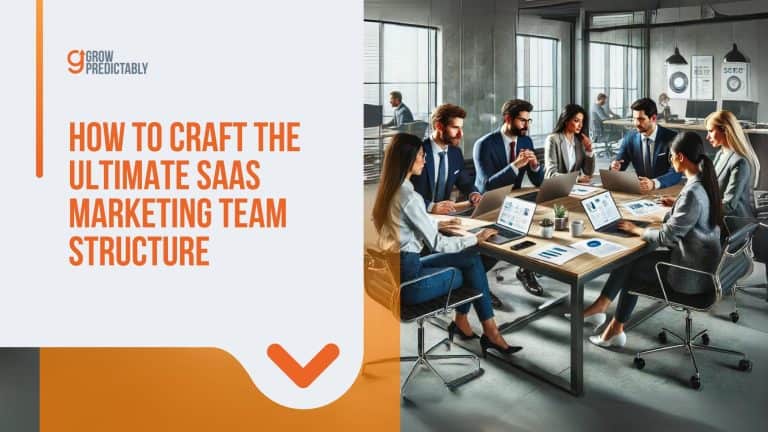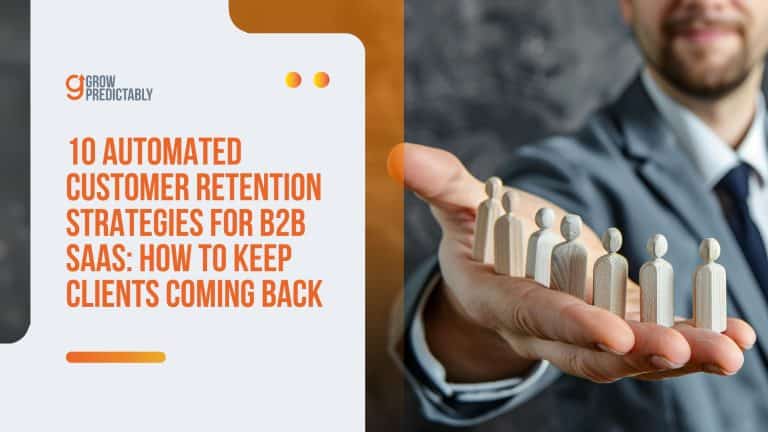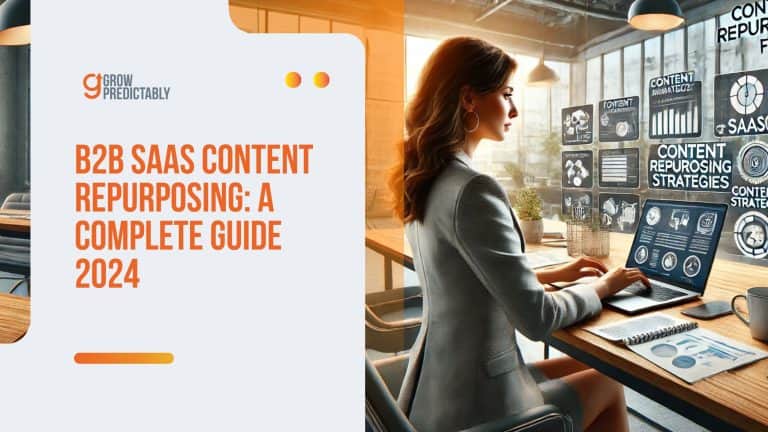Mastering Mapping the B2B SaaS Buyer’s Journey: A Practical Guide
You’re throwing ads, emails, and content at leads, hoping something sticks.
But nothing moves the needle.
Here’s the issue: you don’t know what stage buyers are in, and your strategy’s all over the place.
Fixing this means mapping the b2b saas buyer’s journey the RIGHT way.
See how to stop the guesswork and make every touchpoint count.
Ready to find out how?
The Problem with B2B Customer Journeys
Most B2B companies have a customer journey that’s about as organized as a toddler’s toy box.
According to HubSpot’s State of Marketing Report, 82% of B2B decision-makers think their customer journey is too complicated.
Here’s why this matters: Every point of confusion is a point of abandonment.
Here’s the issue: you don’t know what stage buyers are in their buying process, and your strategy is all over the place.
Your customers don’t care about your internal processes.
Understanding how customers interact with your brand throughout their journey is crucial.
They care about solving their problems.
Yet most B2B companies force prospects through a maze of demos, qualification sales calls, and stakeholder meetings before they can even test the product.
Forrester’s research shows that 74% of B2B buyers conduct more than half their research online before ever talking to a sales rep.
The traditional B2B journey looks something like this:
- Marketing creates content no one reads
- Sales process chases leads that aren’t ready to buy
- Sales reps making non-targeted sales calls
- Customer Success onboards users who aren’t properly qualified
- Product builds features no one asked for
The result?
High customer acquisition costs, extended sales cycles, and churn rates that keep CEOs up at night.
Gartner’s analysis reveals that B2B companies waste 28% of their marketing budget on ineffective customer journey tactics.
But here’s what really kills growth: misalignment between marketing promises and product delivery.
When your prospect’s journey feels like a game of corporate hot potato between departments, you’re not just losing deals – you’re burning money and market share.
The solution isn’t more touchpoints or fancier automation.
It’s about creating a journey so clear and valuable that choosing your solution becomes the obvious next step at every stage.
This is where the Customer Value Journey framework comes in – not as another layer of complexity but as a blueprint for eliminating friction and accelerating growth.
What is CVJ, and Why is it Important?
The Customer Value Journey isn’t just another marketing framework – it’s the backbone of every successful SaaS company’s growth.
With right use, it can deliver the same results to your B2B SaaS as well.
When implemented correctly, it transforms random acts of marketing into a precision instrument for understanding customer emotions and improving customer acquisition and retention.
- The CVJ maps exactly how a prospect evolves from complete stranger to brand evangelist, similar to customer journey maps.
- It eliminates guesswork from your marketing strategy
- It creates predictable, repeatable revenue growth
- It reduces customer acquisition costs by optimizing each touchpoint
McKinsey’s analysis shows that companies that master their customer journey see a 50% increase in satisfaction from their target audience and a 20% reduction in service costs.
It’s fine to celebrate success but it is more important to heed the lessons of failure.
John C. Maxwell
Stages of the Customer Value Journey
A SaaS customer journey map is a structured visualization of every customer interaction with a SaaS company or your B2B SaaS business, emphasizing the importance of touchpoints, emotions, and pain points in the customer experience.
Let’s break down each stage of the journey.
But remember – this isn’t about creating more work.
It’s about making your existing efforts more effective.
- Awareness: Your prospects are drowning in B2B SaaS solutions. The awareness stage isn’t about shouting louder – it’s about showing up exactly where your ideal customer is already looking. Google’s B2B research reveals that 71% of B2B researchers start with a generic search.
- Engagement: This is where you separate yourself from the noise. Sales reps should stop trying to sell features. Start solving problems. The best engagement strategies focus on demonstrating expertise through high-impact content that addresses specific pain points.
- Subscribe: Your email list isn’t just a vanity metric. It’s your owned media channel. Every subscriber represents a potential customer who’s given you permission to continue the conversation. Make it count.
- Convert: The first transaction isn’t about maximizing revenue – it’s about minimizing risk. Offer something so valuable to your target audience that saying “no” becomes harder than saying “yes.”
- Excite: Audience satisfaction doesn’t create growth. A pinch of excitement in the customer experience does. This stage is about exceeding expectations so dramatically that your customers can’t help but talk about you.
- Ascend: Most B2B SaaS companies leave money on the table here. Your existing customers should be your best source of growth. Create clear pathways for customers to increase their investment with you.
- Advocate: Turn your best customers into your best marketers. But don’t just ask for referrals – create systems that make customer loyalty and advocacy natural and rewarding.
- Promote: Active promotion happens when you’ve delivered so much value that customers feel compelled to tell others. It’s the ultimate stamp of approval for their customer loyalty.
Each stage builds on the previous one, creating a flywheel effect that generates sustainable growth.
When one stage underperforms, it affects the succeeding B2B SaaS customer journey stages.
That’s why measuring and optimizing each stage is crucial.
Your CVJ shouldn’t just exist in strategy documents – it should drive every marketing decision you make.
Every email, every landing page, and every customer interaction should move prospects closer to the next stage of their journey.
The latest data shows that companies with a structured customer journey approach achieve 54% greater return on marketing investment.
But here’s what matters: you don’t need to perfect all stages at once.
Start with fixing the biggest leak in your funnel, then systematically optimize each stage.
The goal isn’t to rush B2B SaaS buyers through the journey – it’s to deliver so much value at each stage that moving forward becomes the obvious choice.
5 Steps to Mapping the B2B SaaS Buyer’s Journey

According to Profitwell’s analysis, companies that effectively map their buyer’s journey see an average 32% increase in customer lifetime value.
Marketing and sales teams play a crucial role in this process by delivering relevant content at the right moments and guiding potential buyers through their research and decision-making stages.
This isn’t theory – it’s revenue in motion.
Here’s how to build a sales process that converts:
1. Define Your Company Goals
Start mapping your sales process by being brutally honesty about your metrics.
According to SaaS Capital, companies that set specific, measurable goals for their customer journey see 2.4x higher growth rates.
Don’t just target “more customers” – target specific conversion rates, activation metrics, and revenue milestones.
- Set clear KPIs for each journey stage
- Define what success looks like in hard numbers
- Establish realistic timeframes for achievement
- Create accountability metrics for each department
2. Create Your Target Personas
Your personas aren’t just demographic profiles – they’re buying behavior blueprints.
Gartner’s research shows that B2B companies with detailed buyer personas generate 124% more leads. Map out:
- Decision-making hierarchies in target companies
- Specific pain points that trigger buying behavior
- Revenue impact of solving their problems
- Common objections and hesitations
3. Map Customer Milestones
Every milestone should be a stepping stone to higher customer value.
Break down each stage into measurable actions:
Awareness:
- Content engagement metrics
- Channel-specific conversion rates
- Initial touchpoint effectiveness
Engagement through Advocacy:
- Time-to-value measurements
- Feature adoption rates
- Expansion revenue triggers
- Referral program metrics
4. Find the Gaps
This isn’t about finding problems – it’s about finding profit opportunities.
ChurnZero’s data indicates that identifying and fixing journey gaps can reduce churn by up to 25%.
Focus on:
- Drop-off points in your conversion funnel
- Engagement dead zones
- Communication gaps between stages
- Missed upsell opportunities
5. Test and Optimize
Your journey map is a living document.
According to UserTesting’s research, companies that regularly optimize their buyer’s journey see a 56% higher conversion rate.
Implement:
- Weekly data review cycles
- A/B testing for critical touchpoints
- In-app notifications to engage users at critical moments
- Customer feedback loops
- Continuous improvement protocols
This isn’t about perfection – it’s about progression.
Every improvement in your journey mapping compounds over time, creating a self-reinforcing cycle of growth.
Start with your biggest revenue leaks, fix them systematically, and keep pushing forward.
Journey mapping isn’t just documentation – it’s your blueprint for predictable revenue growth.
The companies that win aren’t the ones with the most features or the biggest budgets.
They’re the ones that understand and optimize every step of their customer’s journey.
Critical B2B Customer Journey Touchpoints Based on CVJ Stages
Your B2B SaaS company is bleeding money if you’re not tracking and optimizing every customer experience across the Customer Value Journey.
These touchpoints aren’t just data points – they’re revenue opportunities that directly impact your bottom line.
Dedicated account managers are crucial in nurturing key accounts and providing ongoing customer support, ensuring these opportunities are maximized.
According to McKinsey’s B2B Customer Experience Survey, companies that effectively manage their B2B customer touchpoints see a 10-15% revenue increase and a 10-20% cost reduction.
Here’s exactly what happens at each CVJ stage and the critical touchpoints you need to master:
1. Awareness Stage Touchpoints
- Search engine optimization and paid advertising campaigns
- Industry conference and webinar presentations
- Social media content strategy and execution
- Press releases and media coverage
- Strategic partnership visibility
2. Engagement Stage Touchpoints
- Website content interaction metrics
- Blog post engagement rates
- Social media comments and shares
- Video content watch time
- Interactive tool usage statistics
3. Subscribe Stage Touchpoints
- Email newsletter signup process
- Lead magnet download completion
- Webinar registration flow
- Free resource access points
- Community membership requests
4. Convert Stage Touchpoints
- Free trial activation process
- Demo booking system
- Initial purchase completion
- Micro-commitment fulfillment
- Low-risk offer acceptance
5. Excite Stage Touchpoints
- First success milestone achievement
- Initial product value realization
- In-app notifications to highlight early wins and milestones
- Welcome sequence completion
- Early wins documentation
- Customer satisfaction measurement
6. Ascend Stage Touchpoints
- Upgrade pathway presentation
- Premium feature adoption
- Cross-sell opportunity engagement
- Higher-tier package consideration
- Additional service acceptance
7. Advocate Stage Touchpoints
- Customer testimonial submissions
- Case study participation
- Social proof generation
- Product review completion
- Reference program enrollment
8. Promote Stage Touchpoints
- Affiliate program participation
- Partner program engagement
- Customer referral generation
- Brand ambassador activities
- Co-marketing opportunities
Recent data from Gartner shows that B2B buyers spend only 17% of their time meeting with potential suppliers when considering a purchase.
This means every touchpoint within each CVJ stage must be optimized for maximum impact.
Your optimization strategy across all CVJ stages needs to focus on three core elements:
- Speed of response at each stage
- Clarity of communication throughout the journey
- Value delivery at every touchpoint
Implement tracking systems for each CVJ stage, measure progression metrics, and continuously refine based on real user feedback.
This isn’t about adding more touchpoints – it’s about making each existing touchpoint within the CVJ framework generate measurable results.
Every touchpoint within the Customer Value Journey should move your prospect closer to the next stage.
If it doesn’t serve this purpose, either optimize it or eliminate it entirely.
Monitor these interactions religiously and adjust your approach based on data-driven insights from your customer’s actual journey through each stage.
Role of Customer Data and Personas in the Customer Value Journey
Action springs not from thought, but from a readiness for responsibility.
Dietrich Bonhoeffer
The difference between companies that scale and those that stall often comes down to how they use consumer data.
According to Segment’s State of Personalization Report, B2B companies leveraging consumer data effectively see a 171% increase in their annual revenue.
Understanding Customer Data and Personas
Your consumer data isn’t just numbers in a spreadsheet – it’s the blueprint for your entire revenue engine.
Salesforce’s research shows that companies using data-driven personas convert 5-8x more prospects than those running on assumptions.
- Revenue impact per customer segment
- Decision-maker influence patterns
- Implementation success indicators
- Expansion revenue triggers
Customer Insights as a Marketing GPS
Every customer interaction leaves breadcrumbs that point to bigger opportunities.
According to Forrester, B2B companies that leverage customer behavior data see a 36% higher customer lifetime value.
Critical data points at each stage:
- Awareness: Channel effectiveness and content engagement patterns
- Engagement: Problem-solution alignment and feature interest
- Convert: Decision triggers and objection patterns
- Advocate: Success indicators and referral behaviors
Strategic Data Collection
Your data collection strategy needs to mirror your customer’s evolution.
McKinsey’s analysis reveals that progressive data collection – gathering deeper insights as customers advance through their journey – increases conversion rates by 43%.
Priority metrics by stage:
- Early Stage: Intent signals and engagement patterns
- Mid-Journey: Product usage and value realization
- Advanced Stage: Expansion readiness and advocacy potential
The Feedback Loop
This isn’t just about collecting data – it’s about creating a self-improving system.
Companies that implement structured feedback loops see their customer acquisition costs drop by 27%, according to OpenView Partners.
Key components:
- Real-time data analysis protocols
- Cross-functional insight sharing
- Automated personalization triggers
- Continuous optimization cycles
Your consumer data strategy should work like compound interest – each insight builds on the previous one, creating exponential value over time.
Tools for Mapping Your B2B SaaS Customer Journey

When it comes to building your B2B SaaS customer journey, using the right tools isn’t just about efficiency – it’s about revenue.
SaaS customer journey maps provide detailed insights into the various types and stages of B2B SaaS interactions, highlighting the unique aspects of visualizing user relationships with software at each touchpoint.
According to G2’s Software Impact Report, companies using dedicated journey mapping tools see a 42% higher conversion rate from trial to paid.
The Enterprise Solutions
Enterprise-grade journey mapping tools deliver comprehensive analytics and integration capabilities that directly impact your bottom line.
According to Forrester’s Wave Report, companies using integrated solutions like HubSpot see a 31% reduction in customer acquisition costs.
Key Enterprise Tools:
- HubSpot ($800/month) – Complete journey orchestration
- Salesforce Journey Builder ($1,250/month) – Advanced automation capabilities
- Adobe Journey Optimizer ($1,500/month) – AI-powered optimization
Enterprise solutions provide:
- End-to-end journey visibility
- Cross-channel tracking capabilities
- Advanced attribution modeling
- Predictive analytics
Mid-Market Solutions
For growing companies needing robust features without enterprise complexity, mid-market solutions offer the sweet spot of functionality and value.
Product Led Institute’s research shows these tools can improve journey optimization by 47%.
Mid-Market Options:
- Lucidchart ($9/user/month) – Visual journey mapping
- Miro ($16/user/month) – Collaborative journey design
- UXPressia ($39/user/month) – Customer journey analytics
These solutions excel at:
- Real-time collaboration
- Template-based mapping
- Integration flexibility
- Quick implementation
The key isn’t just having these tools – it’s using them to create actionable insights.
Every tool should serve a specific purpose in understanding and optimizing your customer’s journey from first touch to advocacy.
The most expensive tool isn’t always the best fit.
Choose based on your specific needs, the size of your marketing or sales team, and growth stage.
The right tool is the one that helps you execute your strategy consistently and measure results effectively.
The Importance of Customer Avatar Canvas
Creating an effective customer avatar isn’t just about filling out a template – it’s about building a strategic framework that drives measurable business outcomes.
According to recent research by HubSpot, companies that exceed their revenue goals are 71% more likely to have documented buyer personas than companies that miss their targets.
The Customer Avatar Canvas transforms abstract consumer data into actionable insights that directly impact your bottom line.

Steps to Success
Your customer avatar is the cornerstone of every marketing decision you make.
It’s the difference between shooting in the dark and making calculated moves that generate consistent returns.
The Canvas methodology breaks down complex consumer data into clear, actionable segments that drive results across your entire marketing funnel.
- Demographics and Pain Points Integration: Map every demographic detail against specific pain points. This isn’t just about knowing their age or income – it’s about understanding how these factors directly influence their purchasing decisions and behavior patterns.
- Interaction Pattern Analysis: Track and analyze every touchpoint in your customer’s journey. Monitor engagement metrics, conversion patterns, and drop-off points to identify exactly where and why customers take action or hesitate.
- Transformation Mapping: Document the complete before-and-after state of your customer’s journey. This includes tracking measurable improvements in their business metrics, operational efficiency, and bottom-line results after implementing your solution.
- Data-Driven Refinement: Continuously update your avatar based on real performance data. Use A/B testing results, customer feedback, and sales data to refine your understanding of what truly motivates your target market.
The key to maximizing the Canvas’s effectiveness lies in its implementation.
According to a study by Edelman, 81% of buyers trust companies that demonstrate a deep understanding of their business challenges.
Your avatar should evolve based on concrete data, not assumptions.
Implementation velocity matters more than perfection.
Start with your current understanding of your customer base and refine it as you collect more data.
Top-performing companies consistently show that rapid implementation and data-driven refinement outperform extended planning phases.
Cross-Team Integration: Ensure sales, marketing, and product teams all contribute insights to your avatar development.
Weekly Data Reviews: Schedule regular reviews of customer interaction data to identify emerging patterns and opportunities.
Quarterly Avatar Updates: Systematically update your avatar based on accumulated data and market changes.
Remember, your Customer Avatar Canvas should be a living document that evolves with your business and market dynamics.
The most successful businesses treat their avatar as a dynamic tool that guides every strategic decision, not just a one-time exercise in customer profiling.
According to McKinsey, companies that regularly update their customer personas see 15-20% higher conversion rates across their marketing campaigns.
Challenges and Solutions in Journey Mapping
Every successful business operation depends on understanding your customers’ precise path from first contact to loyal advocate.
The customer journey mapping process, while critical, presents complex challenges that demand sophisticated solutions.
According to recent research by Gartner, 76% of B2B buyers report that their latest significant purchase was very complex or difficult.

Common Roadblocks
The journey mapping process frequently encounters several critical obstacles that impede effective implementation.
Understanding these challenges is the first step toward developing targeted solutions that drive real results.
1. Data Fragmentation
Multiple systems capturing different aspects of customer interaction create disconnected data silos:
- CRM systems tracking interactions from your sales process
- Marketing automation platforms monitoring engagement
- Customer service tools recording support interactions
- Social media platforms gathering feedback and sentiment
2. Stage Transition Ambiguity
Unclear definitions of progression criteria between journey stages:
- Lack of defined behavioral indicators
- Inconsistent tracking mechanisms
- Missing trigger points for stage advancement
3. Success Metric Challenges
Difficulty in establishing and measuring meaningful success metrics:
- Complex attribution models
- Multiple touchpoint interactions
- Long sales cycles with numerous influence points
4. Cross-functional Alignment
Teams operating independently without shared customer understanding:
- Misaligned departmental objectives
- Inconsistent consumer data interpretation
- Competing priorities and resources
The Good News
These challenges, while significant, can be systematically addressed through the Customer Value Journey framework.
According to McKinsey, organizations implementing structured journey mapping solutions see a 15-20% reduction in service costs and a 10-15% increase in revenue from existing customers.
Key Understanding
Journey mapping transcends conventional documentation – a dynamic system requiring continuous refinement and adaptation.
Research by Aberdeen Group shows that companies with strong journey mapping processes achieve 18x faster average sales cycle and 56% more revenue from upsell and cross-sell efforts.
- Dynamic Adaptation: Regular updates based on customer feedback and behavioral data
- Cross-functional Integration: Unified view of customer journey across all departments
- Metric-Driven Refinement: Continuous optimization based on performance data
- Customer-Centric Evolution: Adaptations driven by changing customer needs and preferences
The journey mapping process must evolve from a static document to an active tool that guides strategic decision-making across your organization.
This approach ensures that your customer journey map remains relevant and effective in driving business growth and customer loyalty.
FAQs
Taking Action: Your Customer Journey Starts Now
The Customer Value Journey framework isn’t just another business tool – it’s a proven system that transforms how businesses build lasting customer relationships.
Throughout this guide, we’ve explored how the Customer Avatar Canvas is the foundation for understanding and optimizing each stage of your customer’s journey.
The key to success lies in taking immediate, focused action.
Rather than attempting to perfect every stage simultaneously, identify the single area where your business needs the most improvement.
Remember, the businesses that thrive aren’t those with perfect systems – they’re the ones that consistently identify opportunities for improvement and take decisive action to optimize them.
Your next step awaits.

